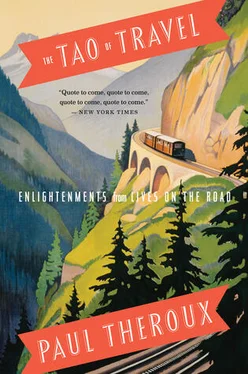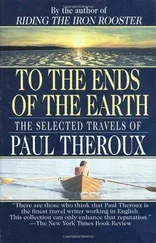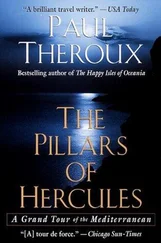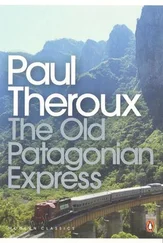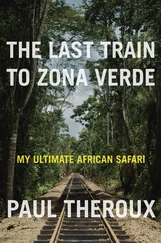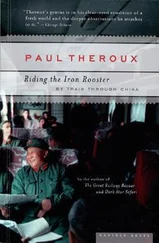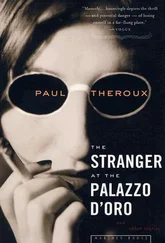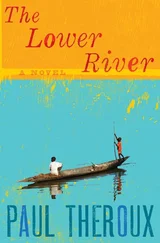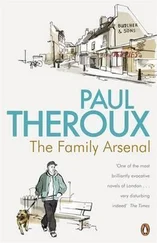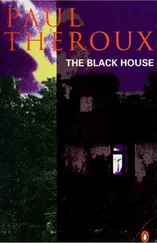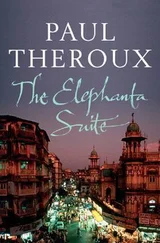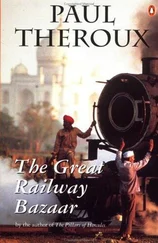— Paul Bowles, "Tangier," Gentleman's Quarterly (1963) (Note: Bowles
based his 1985 short story "Hugh Harper" on this man's tastes.)
Evelyn Waugh on Tasso in British Guiana
Tasso is prepared in this way. The killing of a beast [pig in this case] is an event of some importance in the immediate neighbourhood. Indians get news of it and appear mysteriously like gulls round a trawler when the catch is cleaned. A few choice morsels are cut away and cooked and eaten fresh. The Indians carry off the head and the entrails. The rest is sliced into thin slabs, rolled in salt and hung up to dry. A few days of sun and savannah wind reduce it to a black, leathery condition in which it will remain uncorrupt indefinitely. Even the normally omnivorous ants will not touch it. It is carried under the saddle above the blanket to keep it tender and protect the horse from galling. When the time comes to eat it, it is scrubbed fairly clean of dust and salt and boiled in water. It emerges softened but fibrous and tasteless.
I can conceive it might be possible for a newcomer to stomach a little farine with a rich and aromatic stew; or a little tasso with plenty of fresh vegetables and bread. The food of the savannah is farine and tasso and nothing else.
— Ninety-two Days (1934) (In A Handful of Dust, Waugh's
captive hero Tony is given " tasso at noon… farine and
tasso and sometimes some fruit for supper.")
For a Sharecropper in Alabama, Hardly a Crumb
"Sometimes it don't seem possible that we're living at all, especially when I wake up in the morning and see the children getting up and dressing and walking around in the kitchen where there's hardly a crumb of food. They make a fire in the cook-stove and I scrape together a little corn meal, when there's any to scrape, and I cook it with salt and water. Once in a while we have some molasses, or maybe just some sugar-water to eat with it. When noontime comes, they start another fire, and I cook some more cornbread. A lot of times lately I've just sat and wondered if there's anything else in the world to eat. I know there must be other things in the world to eat, because the rich wouldn't eat cornbread, and I wouldn't if I could help it. Not just cornbread and nothing else. Once in a while we have some store-bought canned beans, just one or two cans among us, and that don't go far when there's nine hungry children besides me. The two oldest boys manage to earn a little money somehow, and they bring home all they make. Altogether, what money there is comes to two or three dollars a week. We eat on that, except for the twenty-five cents a week house rent I pay the landlord. We've been getting along somehow for three years since my husband died. Every time it rains hard all of us have to crawl under the house to keep from getting wet, because I don't reckon there's a landlord in the country who would patch a roof for only twenty-five cents a week rent."
— quoted in Erskine Caldwell and Margaret Bourke-White,
You Have Seen Their Faces (1937)
In Tibetan Cuisine, Meat Is a Rarity
The staple food in this region is tsampa. This is how they prepare it. You heat sand to a high temperature in an iron pan and then pour barley corns onto it. They burst with a slight pop, whereupon you put the corns and the sand in a fine meshed sieve through which the sand runs: after this you grind the corn very small. The resulting meal is stirred up into a paste with butter tea or milk or beer and then eaten. The Tibetans make a special cult of tsampa and have many ways of preparing it. We soon got accustomed to it, but never cared much for butter tea, which is usually made with rancid butter and is generally repugnant to Europeans. It is, however, universally drunk and appreciated by the Tibetans, who often drink as many as sixty cups in a day. The Tibetans of Kyirong, besides butter tea and tsampa, eat rice, buckwheat, maize, potatoes, turnips, onions, beans, and radishes. Meat is a rarity, for as Kyirong is a particularly holy place no animal is ever slaughtered there. Meat appeared on the table only when it had been brought in from another district or, more often, when bears or panthers left part of their prey uneaten.
— Heinrich Harrer, Seven Years in Tibet (1953)
Redmond O'Hanlon's Jungle Tuck
TURTLE BRAIN
Chimo and Culimacare joined us from Chimo's house for breakfast and Simon returned, silent, from his walk. We ate turtle (rich, chewy) and manioc (like sawdust). Simon, declining both, opened a tin of Spam and sat apart on a rock of his own. Galvis, intending to cheer up his new friend, went to sit beside him…
Galvis took a severed turtle head out of his mess tin, picked its brains out from the neck with a fork, ate them, and turned to Simon. He held the blackened head in his fingers in front of Simon's face and moved the jaws open and shut.
"Quack!" said Galvis. "Quack! Quack! Quack!"
— In Trouble Again (1988)
ARMADILLO RISOTTO
As night fell we unloaded our ordinary stores from Chimo's dugout and, leaving Valentine on guard, we set off downstream with the presents, with bowls of manioc, ready-cooked spaghetti, and — the centerpiece — our giant pot full to the brim with agouti and armadillo risotto.
— In Trouble Again
MONKEY EYES
We cut steps up the high muddy bank and made camp. Chimo and Pablo spread palm fronds on the ground and began to prepare the Howler monkey, scalding it with boiling water and scraping off the fur. Its skin turned white, like a baby's.
That night, when Pablo had jointed the body and Galvis boiled it, Chimo handed me a suspiciously full mess tin. As I spooned out the soup the monkey's skull came into view, thinly covered in its red meat, the eyes still in their sockets.
"We gave it to you specially," said Chimo with great seriousness…"If you eat the eyes we will have good luck."
The skull bared its broken teeth at me. I picked it up, put my lips to the rim of each socket in turn, and sucked. The eyes came away from their soft stalks and slid down my throat.
— In Trouble Again
ELEPHANT NOSE
"I give up," said Lary, scrutinizing the very tough, gristly, grey lumps of meat hiding among the fresh green manioc-leaf saka-saka in his mess-tin…"Marcellin," said Lary, chewing hard, "what is this stuff?"
"Elephant nose!"
Lary set down his mess-tin. He stood up, lurched slightly, held on to the corner of the hut, retched twice, and was sick onto the ground.
— No Mercy (1997)
Bread Famine in the Sierra
July 6 [1869] — Mr. Delaney has not arrived, and the bread famine is sore. We must eat mutton a while longer, though it seems hard to get accustomed to it. I have heard of Texas pioneers living without bread or anything made from the cereals for months without suffering, using the breast-meat of wild turkeys for bread. Of this kind they had plenty in the good old days when life, though considered less safe, was fussed over the less. The trappers and fur traders in the Rocky Mountain regions lived on bison and beaver meat for months. Salmon-eaters, too, there are among both Indians and whites who seem to suffer little or not at all from want of bread. Just at this moment mutton seems the least desirable of food, though of good quality. We pick out the leanest bits, and down they go, against heavy disgust, causing nausea and an effort to reject the offensive stuff. Tea makes matters worse, if possible. The stomach begins to assert itself as an independent creature with a will of its own. We should boil lupine leaves, clover, starchy petioles, and saxifrage rootstocks like the Indians… We chew a few leaves of ceanothus by way of luncheon, and smell or chew the spicy monardella for the dull headache and stomach-ache that now lightens, now comes muffling down upon us and into us like fog. At night more mutton, flesh to flesh, down with it, not too much, and there are the stars shining through the Cedar plumes and branches above our beds.
Читать дальше
